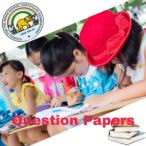HISTORY & CIVICS
H.C.G. – Paper – 1
PART-I
Attempt all questions from this Part
![]() Q. 1 (a) Name the two Houses of the Indian Parliament.
Q. 1 (a) Name the two Houses of the Indian Parliament.
(b) What is meant by the term ‘Session’?
(c) How is the Speaker of the Lok Sabha elected?
(d) What is the term of office of a Rajya Sabha member?
(e) Who is the Supreme Commander of the Armed forces of India?
(f) What is the normal term of office of the Vice President of India?
(g) Who appoints the Prime Minister of India?
(h) State the body that decides the major policies of the Government.
(i) Name the Courts that are empowered to issue Writs for the enforcement of Fundamental Rights.
(j) Mention any one advantage of the Lok Adalat.
![]() Q. 2 (a) Mention any two contributions of Bipin Chandra Pal in promoting Nationalism.
Q. 2 (a) Mention any two contributions of Bipin Chandra Pal in promoting Nationalism.
(b) State any two methods adopted by the Early Nationalists in the National Movement.
(c) Why is October 16, 1905 regarded as an important day in the history of the Indian National Movement?
(d) Name any two leaders of the Khilafat Movement.
(e) State any two causes for the Non-Cooperation Movement.
(f) Mention any two objectives of the Forward Bloc.
(g) What was meant by the term ‘Imperialism’, as a cause for World War I?
(h) Give any two reasons for the rise of Fascism.
(i) Name the two International Organisations that were formed, one as a consequence of World War I and the other after World War II.
(j) Give the full form of UNICEF and WHO.
PART-II
SECTION A
Attempt any two questions from this Section
![]() Q. 3 With reference to the Union Legislature, answer the following questions:
Q. 3 With reference to the Union Legislature, answer the following questions:
(a) Explain any three Legislative powers of the Union Parliament.
(b) State any three exclusive powers of the Lok Sabha that is not enjoyed by the other House.
(c) List any four functions of the Speaker of the Lok Sabha.
![]() Q. 4 The Executive Power of the Indian Union is vested in the President. In this context, answer the following:
Q. 4 The Executive Power of the Indian Union is vested in the President. In this context, answer the following:
(a) How is the President of India elected? State the composition of the Electoral College that elects him.
(b) Explain any three Discretionary Powers of the President.
(c) Mention any four Executive Powers of the President.
![]() Q. 5 With reference to the Supreme Court as the Apex Court in our Indian Judiciary, explain the following:
Q. 5 With reference to the Supreme Court as the Apex Court in our Indian Judiciary, explain the following:
(a) Any three cases that come under the Original Jurisdiction of the Supreme Court.
(b) Power of Judicial Review.
(c) Supreme Court as a Court of Record.
SECTION B
Attempt any three questions from this Section
![]() Q. 6 By 1857, conditions were ripe for a mass uprising in the form of the Great Revolt of 1857. In this context, explain the following:
Q. 6 By 1857, conditions were ripe for a mass uprising in the form of the Great Revolt of 1857. In this context, explain the following:
(a) Any three Economic causes for the revolt of 1857.
(b) Any three Military causes.
(c) Any three Political causes of the revolt.
![]() Q. 7 With reference to the Mass Phase of the National Movement under the leadership of Gandhi, answer the following:
Q. 7 With reference to the Mass Phase of the National Movement under the leadership of Gandhi, answer the following:
(a) Briefly explain the Dandi March of 1930.
(b) State any three reasons for the launching of the Quit India Movement.
(c) Explain any four significant effects of the Quit India Movement.
![]() Q. 8 With reference to the Partition Plan, answer the following:
Q. 8 With reference to the Partition Plan, answer the following:
(a) (i) Name the last Viceroy of India.
(ii) State any two reasons for him to come to India.
(b) Mention any three proposals under his plan. (c) State any four reasons for the Congress to finally accept the Plan.
![]() Q. 9
Q. 9
(a) Name the organization associated with the above Emblem. Mention any two of its objectives.
(b) Mention any three functions of WHO, as its agency.
(c) Name the Principal Judicial Organ of this organization and explain its composition.
![]() Q. 10 With reference to the Second World War and the Non-Aligned Movement, answer the following:
Q. 10 With reference to the Second World War and the Non-Aligned Movement, answer the following:
(a) Explain briefly three reasons for the Dissatisfaction with the Treaty of Versailles.
(b) State any three consequences of the Second World War.
(c) Mention any four chief architects of the Non-Aligned Movement.


